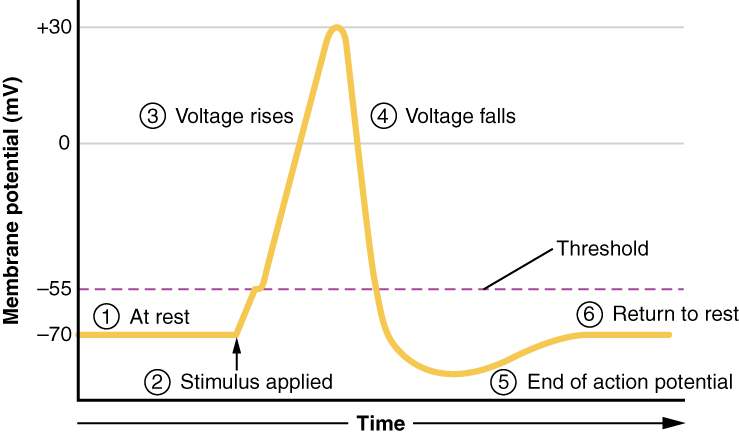17 Refractory periods
Learning Objectives
After reading this section, you should be able to-
- Distinguish between absolute and relative refractory periods and compare the physiological basis of each.
- Explain the impact of absolute and relative refractory periods on the activity of a neuron.
An action potential takes place in about 2 milliseconds (Figure 17.1). During this time, the neuron is unable to initiate another action potential, a phenomenon known as the refractory period. There are two phases of the refractory period: the absolute refractory period and the relative refractory period. During the absolute refractory period, another action potential will not start.
Absolute refractory period
The absolute refractory period is a brief period during which a neuron is unresponsive to any additional stimuli, regardless of their strength. This refractory period occurs immediately after the initiation of an action potential and is crucial for maintaining the orderly transmission of signals in the nervous system. The absolute refractory period is primarily a consequence of the inactivation of voltage-gated sodium channels. These channels allow sodium ions to rapidly enter the neuron, triggering depolarization and the action potential. Following depolarization, the voltage-gated sodium channels undergo a conformational change, entering an inactivated state where they are temporarily unable to reopen. This inactivation prevents the influx of additional sodium ions, making it physiologically impossible for the neuron to generate another action potential during this brief but critical period. The absolute refractory period ensures the directionality of signal propagation and prevents the occurrence of overlapping action potentials, contributing to the precision and reliability of neuronal communication.
Relative refractory period
The relative refractory period is a brief time after an action potential when a neuron is harder to excite than usual—but not impossible. During this time, the membrane potential is more negative than its resting level (a state called hyperpolarization), so a stronger-than-usual stimulus is required to trigger another action potential. This occurs because voltage-gated K⁺ channels remain open and Na⁺ channels haven’t fully reset. This phase helps regulate how often a neuron can fire and ensures that signals remain spaced out and controlled.
In contrast to the absolute refractory period, this phase represents a partial recovery—the neuron is regaining its ability to fire. One way to understand these two refractory periods is to think about flushing a toilet. During the absolute refractory period, the toilet is already flushing—you can’t flush it again, no matter how hard you try. During the relative refractory period, the tank is refilling. You can flush it again, but it takes more force. Just like the toilet, the neuron needs time to reset before it can fire again—especially during the relative period.

1. The membrane starts at rest (–70 mV).
2. A stimulus causes depolarization.
3. If threshold is reached (–55 mV), an action potential begins.
4. The voltage rapidly rises to +30 mV.
5. It then quickly repolarizes and overshoots the resting level.
6. After hyperpolarization, the membrane returns to rest.
Adapted from Anatomy & Physiology by Lindsay M. Biga et al, shared under a Creative Commons Attribution-ShareAlike 4.0 International License, chapter 12.
a period of time in which a cell cannot experience another action potential
the time interval during which a neuron, having just undergone an action potential, cannot experience another action potential no matter the strength of the stimulus
the time interval during which a neuron, having just undergone an action potential, exhibits increased resistance to being triggered for another action potential

